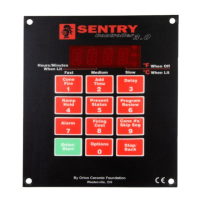ting the controller changes the thermocouple se
-
lection to Type-S.
1 From [IDLE], press OPTIONS repeatedly until
[TC] appears.
2 Press ENTER. Use the 1 or 3 key to select [K],
[N], [R]or [S].
3 After selecting one of the above, press ENTER. Press
STOP to return to
[IDLE].
F/C / Selecting Between °F and °C
Temperature Display
The controller operates in your choice of Fahrenheit or
Celsius temperature. In °C display, a lighted dot appears in
the lower right. In °F, it disappears. To switch from °F to °C
or vice versa:
1 From [IDLE], press OPTIONS repeatedly until
[F/C] appears.
2 Press ENTER. Use the 1 or 3 key to select [F]or
[C.].
3 After selecting one of the above, press ENTER.
Press STOP to return to
[IDLE].
°F/°C Temperature Conversion Formulas
Below are formulas for converting temperture between
°F and °C. Converting a firing rate requires a different for-
mula than converting a firing temperature:
Firing to a Temperature
(i.e. “Fire to 1600°F.” 1600°F = 871°C)
(°C x 1.8) +32 = °F
(°F - 32) ÷ 1.8 = °C
Firing Rate or Temperature Change
(i.e. “Fire at 200°F per hour” or “Fire 200°F hotter.” 200°F =
111°C)
°Cx1.8=°F
°F÷1.8=°C
TCOS / Thermocouple Offset
Calibrate the Thermocouple(s)
The thermocouple is the rod protruding into the firing
chamber. It measures temperature. K-Type thermocouples
can “drift” as they age, causing a gradual shift in tempera
-
ture readings. Thermocouple Offset calibrates the control
-
ler to compensate for drift.
Note: The thermocouple must protrude into the
firing chamber the correct distance: about ¾” for
¼” wide thermocouples, ½” - 5/8” for 1/8” wide
thermocouples.
Setting Thermocouple Offset
You can enter a temperature change up to 45°F/25°C
higher or lower than the zero factory setting.
1 From [IDLE], press OPTIONS repeatedly until
[TCOS] appears.
2 Press ENTER. [O], or a Thermocouple Offset,
will appear.
3 Using the 1 and 3 keys, enter the new offset. Press
ENTER.
[TCOS] will appear. To return to [IDLE],
press STOP.
Thermocouple Offset Settings
°F Setting °C Setting Result
0 0 No adjustment
H 1-45 H 1-25 Kiln will fire hotter
C 1-45 C 1-25 Kiln will fire cooler
Thermocouple Offset Examples
Setting Result
H 1 Kiln will fire 1° hotter
H 17 Kiln will fire 17° hotter
C 12 Kiln will fire 12° cooler
Multiple-Zone Thermocouple Offset
1 From [IDLE], press OPTIONS repeatedly until
[TCOS] appears.
2 Press ENTER. [TC1] (top thermocouple) will ap-
pear.
3 While [TC1] displays, press OPTIONS. The other
thermocouple(s), then
[TCOS], will appear with
each press of the OPTIONS key.
3 zone kilns:
[TC1] [TC2] [TC3] [TCOS]
2 zone kilns: [TC 1] [TC3] [TCOS]
4 When the correct thermocouple appears, press
ENTER.
5 Using the 1 and 2 keys, enter the new offset. (See
charts above.) Press ENTER. The thermocouple
you adjusted (i.e.
[TC1]) will appear. Select an
-
other thermocouple, if necessary, or return to
[IDLE] by pressing STOP.
AOP1, AOP2 / Auxiliary Outputs
Select Vent Fan or Alarm for the Auxiliary Outputs
The
[AOP1] and [AOP2] (Auxiliary Outputs) are for re
-
ceptacles (called sockets in England) mounted on the kiln
switch box. The outlets can power a kiln vent or an external
alarm, such as a bell. (An AOP outlet is optional and might
not be included on your kiln.)
The choices in the
[AOP1] and [AOP2] options:
I
[VFAN] Kiln Vent or Gas Outlet: This option adds a
display prompt for fan (
[FN]) to each segment during
Ramp-Hold programming (page 15).
I
[CPT] When the kiln fires to completion, and [CPTL]
appears in the display, the controller will turn on power
to the AOP outlet. Plug a bell or other alarm into the
AOP outlet to notify you that the firing is done.
I
[ALRM] Alarm: This choice sends power to the AOP
receptacle whenever the alarm sounds. (See Tempera
-
22 Cone-Fire / Ramp-Hold Do not leave your kiln unattended during operation.

